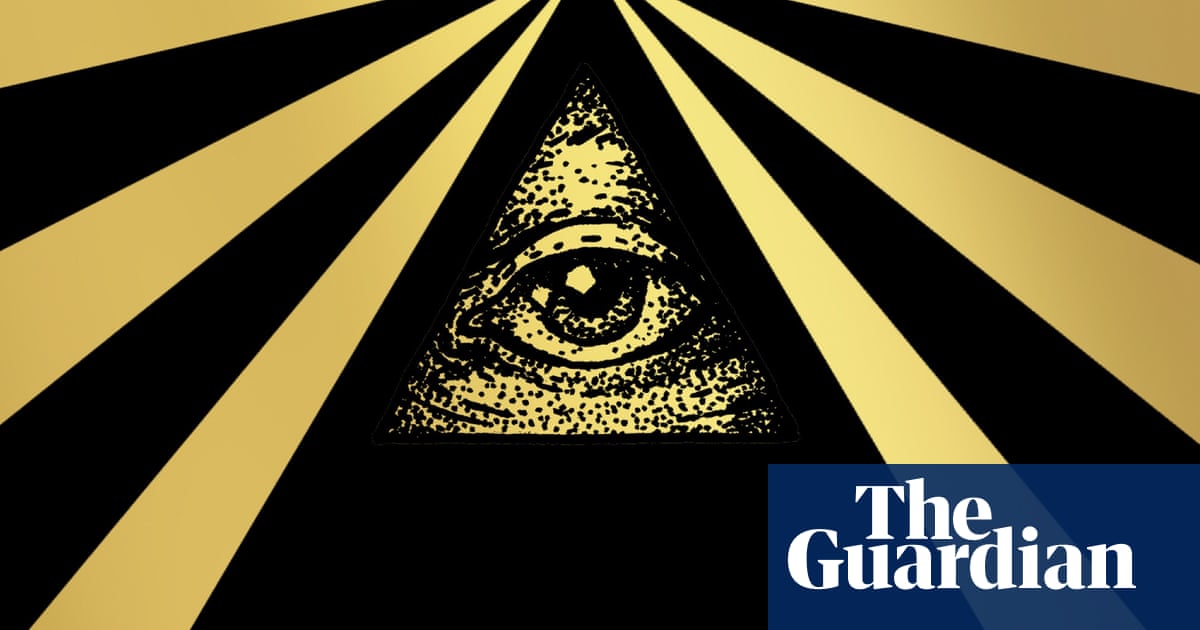
US congressional hearings can be dry affairs but not of late. First there was Robert Kennedy Jr, purveyor of disinformation about vaccines and much else, testifying about big tech censorship. Then David Grusch, a former intelligence officer, claiming that the government knows more than it admits about UFOs: “Non-human biologics had been recovered at crash sites.”
The fact that both captured the public imagination is not so surprising. In a new book, Under the Eye of Power, cultural historian Colin Dickey argues that our hunger for conspiracy theories is less fringe and more mainstream than we like to admit. Fearmongering about secret groups pulling levers of power behind the scenes, “conspiring to pervert the will of the people and the rule of law”, is older than America itself.
From the 1692 Salem witch trials to the American Revolution (thought by some to be a conspiracy organised by the French), from the satanic panic to the Illuminati and QAnon, it has been tempting to dismiss conspiracy theories as an aberration, resonating with a small and marginal segment of the population. But Dickey, 45, came to understand them as hardwired into how many people process democracy.
He says via Zoom from a book-lined room in Brooklyn, New York: “When I was a child I was taught that the Salem witch trials and McCarthy hearings – which I think were taught primarily because Arthur Miller’s The Crucible yokes these two instances together – were the outliers, the standouts in American history when things just got out of hand but we’re mostly very sane and rational, the rest of the justice system works and you don’t have to worry too much.
“But what I found is that those in fact aren’t outliers. I began to see a pattern emerge whereby there’s almost a template for fears of secret societies, of this invisible, undetectable group that is nonetheless doing terrible things behind the scenes.
“It happens again and again; the names change. Sometimes it’s the Catholics, sometimes it’s the Jews, sometimes it’s the satanists, sometimes it’s the socialists or the anarchists. But it recurs with enough frequency that I began to see it as something that gets deployed almost on cue when certain moments arise in American history.”
An early example was Freemasonry, the leading fraternal organisation of the 18th century with members including George Washington, Benjamin Franklin, James Otis and Paul Revere. What began as a teacher of moral, intellectual and spiritual values came to be regarded with hostility and suspicion.
Dickey explains: “Freemasonry went from being a positive social philanthropic fraternal organisation that people like Ben Franklin and Washington were proud to be associated with to increasingly being seen as this parallel shadow government that had infiltrated the country and that people were less and less sanguine about having in their midst. They began to fear this idea of a secret society that didn’t seem beholden to the democratic lawmakers of the country.”
The author also sheds light on attacks on Catholics in the 19th century, driven by a prejudice among Protestants that they were beholden only to a foreign pope and could not act as fully enlightened American citizens.
“Outside Boston, a convent in 1834 was burned to the ground by people who assumed that the priests were using the confessional as some sort of half blackmail, half mind control device to imprison and sexually enslave women against their will, that there were babies being produced that were then being murdered and buried in the catacombs beneath the ground,” he says.
“It’s basically very structurally similar to the contemporary conspiracy theory around Pizzagate or the movie that just came out, Sound of Freedom [popular with QAnon followers]. This idea of the cabal of sexual abusers, which was being used against Catholics in the 1830s, with just a few of the key details changed but more or less the same narrative.”
But something important did shift in the 20th century. Until then most conspiracy theories posited foreign infiltrators trying to harm the American government. If you believed that the US has perfected democracy, it was easier to blame outside saboteurs for anything that went wrong.
“After world war two and the sixties, that gradually but irrevocably changes to the point where now most Americans take it on an article of faith that the government is out to do them harm on some level or another. Conspiracy theories are often marshalled around this idea that people in the government know more and what’s happening here is the result of government actors,” Dickey says.
“You see that with 9/11 conspiracy theories and you see it with the JFK assassination. The idea that the head of state was assassinated and yet, for a large part of the population, the only explanation was that the government itself in some form or another was responsible for this is representative of that sea change.”
There is no doubt that the internet is an important part of the story. Human rights groups blamed anti-Rohingya propaganda on Facebook for inciting a genocide in Myanmar. But the author resists any attempt to shift moral responsibility to social media. It exacerbates some of our latent tendencies, he argues, but those tendencies are there no matter what.
Dickey sees in QAnon both classic strains of conspiracy theory and some new mutations. “There’s this idea of the government insider who is leaking secret information, which we’ve had historically with something like Watergate and Deep Throat, but also the figure who claims that he has been shown classified information and is sharing them is something you hear in UFO conspiracies time and time again. So that felt very classical.
“What does seem new is that QAnon is this weird hybrid of a very dangerous, quite racist and homo- and transphobic conspiracy theory mixed with an online multilevel marketing scheme and also a community forum for puzzle solvers,” he says.
“It is a real blend and synthesis of a bunch of different things that all appeal to slightly different personalities. It’s spread a little wider because it’s able to bring in people who might be otherwise disparate and unconnected and yokes them all under this banner by being vague and nebulous and not attached to too many specific beliefs or practices.”
Then there is the “great replacement” theory, pushed by rightwing figures such as Tucker Carlson, which describes a supposed elite conspiracy to change the demographics of the US by replacing white people with people of colour, immigrants and Muslims. Dickey notes that such conspiracy theories tend to flare up most predictably when there is significant demographic change or previously marginalised groups push for visibility and equality.
“Both with the increased visibility of the LGBTQ community and trans men and women demanding rights and equality, alongside the racial and ethnic identity of America changing, as it always has, these things are combining to create a terror among some people who see this change as too rapid, too inexplicable, too destabilising. Rather than admit that America is constantly in flux, they are seizing upon the idea that this is in fact an artificial change brought about by secret elites who are working behind the scenes to undermine what ‘America’ actually is.”
The phrase “conspiracy theory” was coined by philosopher Karl Popper. In his 1945 book The Open Society and Its Enemies, he discusses the “conspiracy theory of society”: the idea that major events are the “result of direct design by some powerful individuals and groups”.
Dickey explains: “The conspiracy theory of society happens when you get rid of God and ask what’s in his place. What I found in writing the book and thinking through my other research in conspiracy theories is what they do is offer an explanatory mechanism for chaos and disorder and randomness, almost to the point of a quasi-theological explanation.
“Anything that is happening today can be, if you so choose, understood to be part of the incredibly byzantine and hidden plan of the Illuminati that may seem confusing to us on the surface but you can trust as an article of faith that is part of their grand plan. They are both omniscient and omnipotent (unlike God they’re not benevolent) but they are working behind the scenes and that explains the world.
“Even though that’s a malicious and terrible view of the world, for a segment of the population that is more reassuring than a world of pure chaos and disorder. People will cling to this idea that, yes, well, at least we know that this is part of this malevolent world order, even if it’s evil and out to get us.”
What makes an enduring conspiracy theory? One element is that they start with a kernel of truth and grounds for doubt. Dickey acknowledges that scepticism is healthy and the impulse that leads to a conspiracy theory is a fine one. Citizens are not obliged to accept everything they are told at face value.
He says: “Almost any conspiracy theory starts with a legitimate question that I would agree: yeah, let’s look into that, let’s see what we can find. It’s the refusal to accept evidence when the evidence doesn’t pan out in the way that you want it to that leads to problems because then what you have to do is construct an increasingly elaborate conspiratorial framework to explain why you’re not finding the evidence you were hoping for. That’s where you get completely lost in the weeds.”
From MMR to Covid-19, vaccines have been a prime example of how initially reasonable concerns over possible side-effects can career into an insidious irrationality.
“I understand that people might be hesitant and have questions, and yet from a legitimate curiosity or understandable hesitation people then spin out to wildly improbable, indefensible and dangerous conspiracy theories. Time and time again the most virulent conspiracy theories often have some kernel of truth which is then being spun in dramatic and horrible directions,” Dickey says.
Secondly, there is humans’ notoriously short attention span. Dickey writes that conspiracy theories feed on historical amnesia and depend on the belief that what is happening now has never happened before. Many people have therefore been taken aback by former president Donald Trump’s “big lie” of a stolen election and by QAnon, whose followers perceive Democrats are a cabal of Satan worshippers and sex traffickers.
Dickey says: “A lot of Americans were sort of, ‘Well, how could people possibly believe this nonsense? No one has ever thought something this absurd.’ As a result a lot of us were caught flat-footed and didn’t take these things seriously, didn’t respond fast enough until things were already out of control.
“What I wanted to do with this book is to lay out that this is almost like a playbook that gets run and that one step to defeating it is being aware that it’s used like this. When the next one comes along – because there will be a next one – maybe we’ll be able to get out ahead of it a little bit faster.”
Yet acolytes of Trump and QAnon seem impervious to reason. Facts and evidence that contradict their view are attributed to the conspiracy and seen as cause to dig in heels further. Dickey hopes readers of his book will come away with a better understanding of what causes normal, rational and educated people to embrace certain conspiracy theories – and start to think about what they can do to push back on them.
“What almost never works is barking facts and truth at them because people subscribe to these things because they fulfil an existential or emotional need,” he says. “If I was given the keys to the kingdom and asked what to do about it, I would want to start with addressing people’s emotional concerns there.
“What is the underlying existential conflict, the cognitive dissonance? What is the thing that is freaking them out, that is leading them to be susceptible to conspiracy theories, and what can we do as a culture and as a nation to address those existential concerns? You don’t debunk the theories unless you first lay the groundwork for an off-ramp for whatever that emotional need is that led them to embrace the theory in the first place.”
Under the Eye of Power is out now












